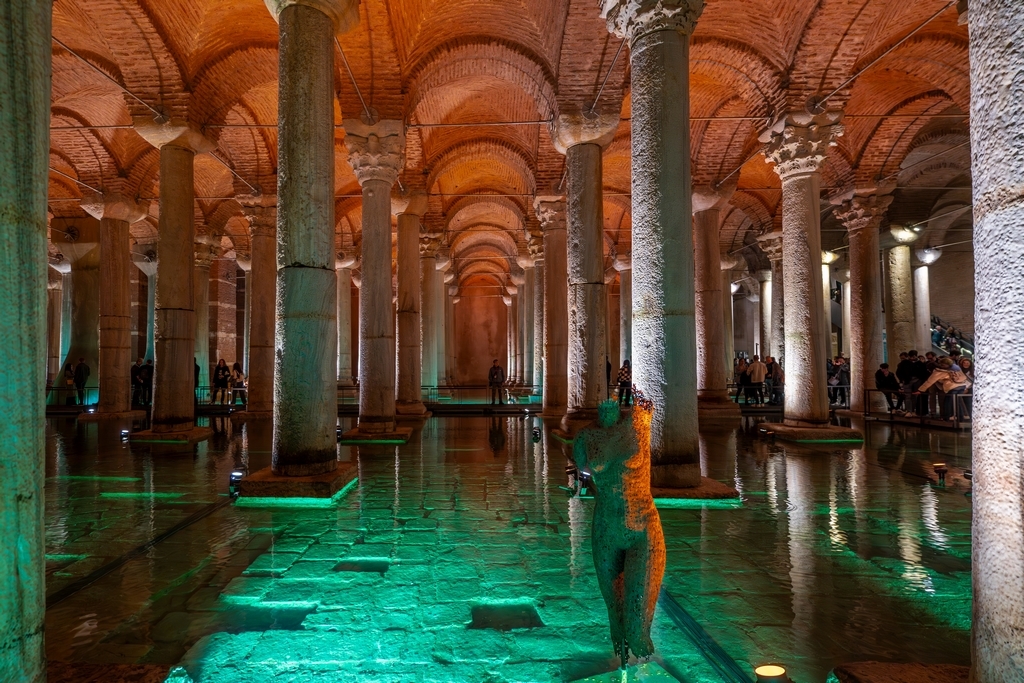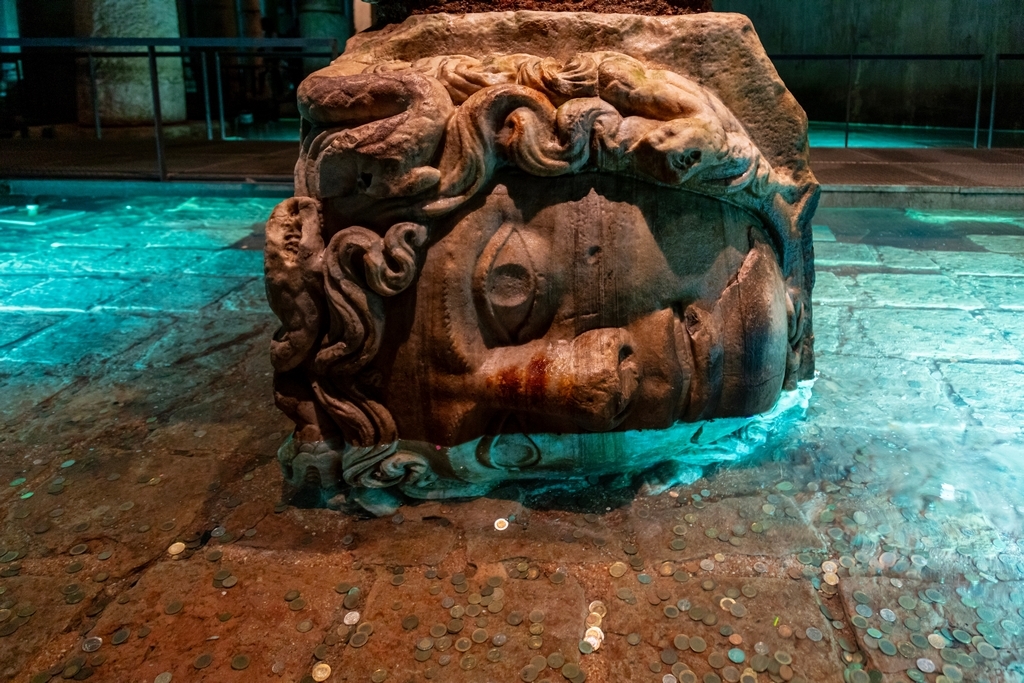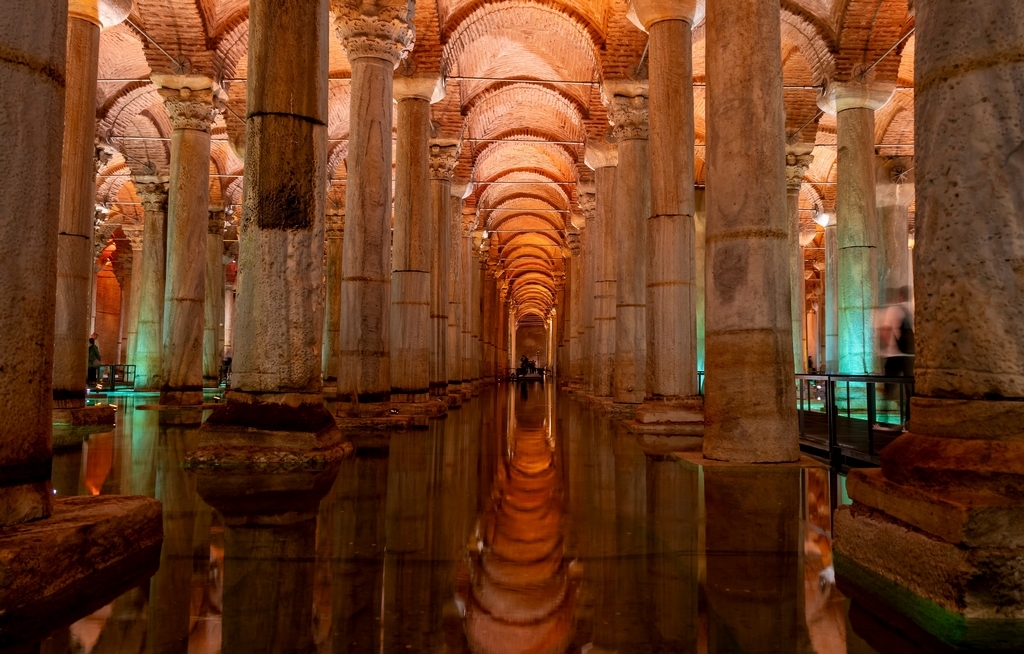Basilica Cistern: Ancient Design & Function


The Basilica Cistern is an extraordinary piece of ancient architecture and watershaping art located in Istanbul, Turkey. Built during the reign of the Byzantine Emperor Justinian I in the 6th century, it represents a marvel of engineering and serves as an important cultural and historical site in Istanbul. today.
By Eric Herman
It’s a work of enduring beauty and utility.
Istanbul’s Basilica Cistern was constructed to provide a water filtration system for the Great Palace of Constantinople and other surrounding buildings. During the Byzantine period, the city had to ensure a continuous water supply, especially in times of siege. The cistern was one of many storage facilities, though it is by far the most famous and largest, capable of holding about 100,000 tons of water. Water was transported ingeniously using gravity from the Belgrade Forest, located 19 kilometers north of the city, via aqueducts including the Valens Aqueduct.
Named after the “Stoa Basilica,” which was once a large public square on the site, the cistern fell into disuse after the Byzantine Empire collapsed in 1453. It was rediscovered in the 16th century by Petrus Gyllius, a scholar from France, who noted that residents were drawing water from holes in their basements and even catching fish from underground.
SYMMETRICAL MASTERY
The Basilica Cistern is remarkable for its vast size and the design symmetry. The underground chamber is approximately 138 meters long and 65 meters wide, covering an area of nearly 9,800 square meters. The ceiling is supported by 336 marble columns, each around nine meters tall, arranged in 12 rows of 28 columns. Most of the columns are Corinthian or Ionic in style, though some feature simpler designs, which suggests that they were repurposed from older structures.
One of the most famous architectural features is the presence of two Medusa heads used as column bases. These heads are placed in an inverted and sideways position, and their origin remains a mystery, though they are believed to have been taken from a Roman-era structure. Their unusual placement has sparked a variety of legends and theories, including the possibility of warding off evil.
The ceiling of the cistern is made of “brick vaults”, which contribute to its robust structural integrity. It is a masterpiece of Byzantine engineering, combining utility with aesthetic grandeur.
UNCOVERING AN ICON
Over the centuries, the Basilica Cistern has gained historic notoriety as a significant cultural legacy. It stands as a testament to the ingenuity of Byzantine engineers and their ability to provide for the city’s needs even in times of conflict. The cistern also represents the complex layering of cultures in Istanbul, reflecting influences from Roman, Byzantine, and Ottoman architecture.
Throughout Ottoman rule, the cistern was largely ignored because the Turks preferred using more open-air sources of water. However, it remained in popular culture as a symbol of the city’s Byzantine past. In modern times, it has also gained global attention after being featured in several films, including James Bond’s “From Russia with Love” and Dan Brown’s “Inferno.”
After its rediscovery in the 16th century, the Basilica Cistern fell into disrepair over the years. It was not until the 1980s that serious restoration efforts began. In 1987, the Turkish government cleaned the cistern, removing significant amounts of mud, and opened it to the public as a museum. The restoration preserved its historical character while ensuring that it remained structurally sound.
Recent preservation efforts have focused on ensuring the cistern remains safe for tourists while protecting its delicate architectural features. Conservation efforts also include the control of humidity and water levels to prevent further deterioration of the ancient stone and brickwork.
TREATING ANCIENT WATERS
In ancient cisterns like the Basilica Cistern, water treatment and management were rudimentary compared to modern techniques, but still effective for their time. Several techniques were employed to ensure water quality remained as good as possible.
- Water Source: Water was usually brought into cisterns from nearby rivers, aqueducts, or rainwater catch systems. As mentioned above, the Basilica Cistern received its water primarily through the Valens Aqueduct from the Belgrade Forest, approximately 19 kilometers away. The aqueduct system was designed to maintain a steady flow of clean water from a fresh source, reducing the risk of stagnant water contamination.
- Filtration: The primary method of water treatment in cisterns was natural filtration. As water passed through the aqueduct channels and into the cisterns, it would naturally filter through layers of soil, sand, and sediment in the aqueduct system. These materials acted as a primitive filtration system, helping to remove larger particles like dirt, leaves, and small debris before the water entered the cistern.
- Sedimentation: Once inside the cistern, sedimentation played an important role. Over time, heavier particles suspended in the water would settle to the bottom, leaving clearer water near the surface. Maintenance crews periodically removed the sludge that collected at the bottom of the cistern, ensuring the water remained clean.
- Sediment Basins: In many ancient cistern systems, including those connected to the Basilica Cistern, sediment basins or smaller holding tanks were used before the water reached the main storage. These basins allowed additional time for dirt, silt, and other impurities to settle, improving the quality of the water before it entered the main cistern.
- Covered structure: The Basilica Cistern, like many other ancient cisterns, was built underground and entirely covered. This design prevented sunlight from reaching the water, which helped to reduce the growth of algae and bacteria, keeping the water fresher for longer periods. The covered design also protected the water from external contaminants like dust, animals, and human waste, which would have been more common in an open-air system.
- Water Flow and Circulation: To maintain water quality and prevent stagnation, the water in cisterns often remained in motion due to a steady inflow and outflow system. Aqueducts and pipes continually fed water into the cistern while the excess was directed out, preventing stagnation, which could lead to bacterial growth or foul odors. In some cases, overflow channels allowed excess water to drain, which kept the stored water fresh.
- Water source: In general, the water source itself played a crucial role in the quality of the stored water. Many of the water sources used for ancient cisterns, such as rivers, streams, or distant reservoirs, were naturally clean and pure, especially when coming from mountain springs or forested areas. In the case of the Basilica Cistern, water from the Belgrade Forest was relatively clean due to its isolation from human habitation and agriculture.
- Physical maintenance: Workers regularly removed debris from the surface, monitored sediment buildup, and cleared out mud and sludge from the bottom of cisterns during periods of maintenance. The Byzantines would have employed people to oversee the function of the cistern and ensure it remained clean for use by the palace and the people of Constantinople.
While rudimentary, these methods were effective for the time, and allowed ancient cities to maintain a stable water supply, even during sieges or times of drought. The engineering principles behind these cisterns reflect a sophisticated understanding of hydrology and infrastructure management, demonstrating how ancient civilizations solved complex problems of urban water supply.
MODERN ATTRACTION
Today, the Basilica Cistern is one of Istanbul’s most popular tourist attractions. Visitors are drawn to its eerie yet serene atmosphere, enhanced by dim lighting and the sound of water dripping from the ceiling. The walkways allow visitors to explore the cistern up close, walking along the ancient columns and viewing the famous Medusa heads.
The cistern’s ambience has also made it a venue for various cultural events, including concerts and exhibitions. The mixture of history, mythology, and engineering marvels makes the Basilica Cistern not only a significant historical site but also a modern cultural landmark.
From its origins as a crucial element in Constantinople’s water system to its role as a symbol of the city’s multi-layered history, it stands today as both a monument to the past and a modern attraction.
References: “Basilica Cistern, Sultanahmet, Istanbul”, Turkey, Europe, lonelyplanet.com; Korzhumbayeva, Aigerim. “Istanbul’s (Constantinople) 6th Century Basilica Cistern.” Electrium Magazine. N.p., 20 July 2012. Web. 06 Nov; “Basilica Cistern,” thebyzatinelegacy.com “The Basilica Cistern.” The Basilica Cistern. Trans. Irfan Koksal. N.p., n.d. Web. 06 Nov. 2016.
Photos: Opening image by Steve Barze | Shutterstock; second photo by Sadet Uslu | Shutterstock, third photo by Nejdet Duzen | Shutterstock.











